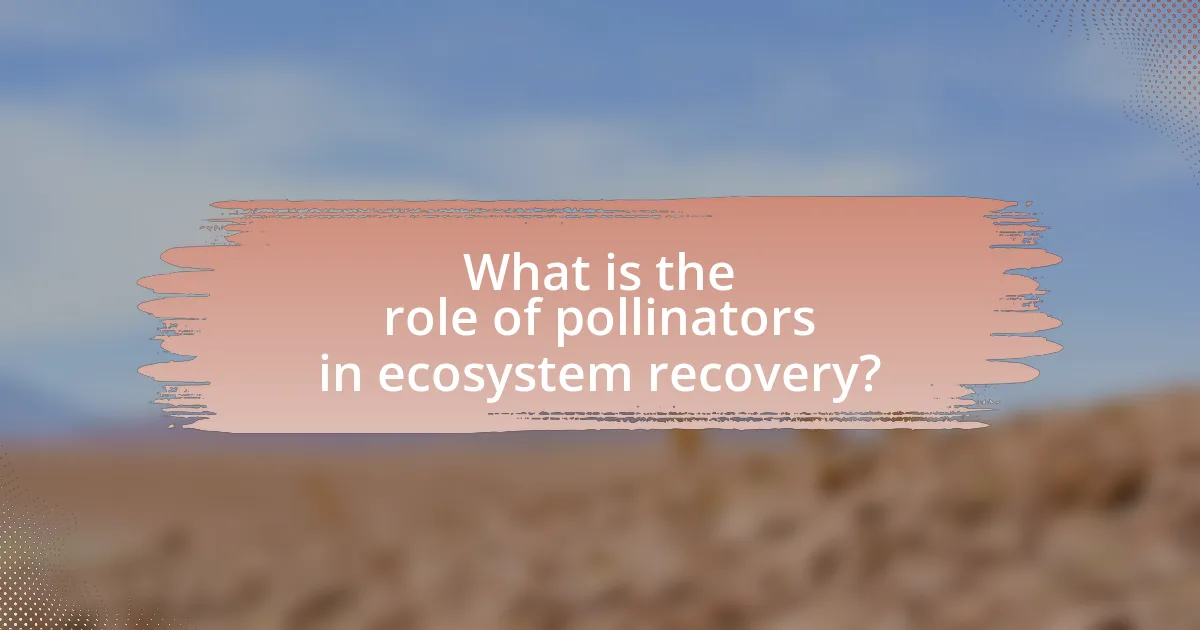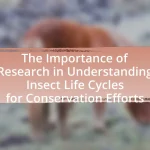Pollinators, including bees, butterflies, and birds, are essential for ecosystem recovery as they facilitate plant reproduction, which is vital for restoring biodiversity and ecosystem functions. Approximately 75% of the world’s flowering plants depend on animal pollination, making these species crucial for food production and maintaining healthy ecosystems. The article explores the role of key pollinators in enhancing biodiversity, the impact of their decline on food security, and the ecological benefits of healthy pollinator populations. It also addresses the challenges facing pollinators today, such as habitat loss and pesticide exposure, and outlines practical steps individuals can take to support these vital species during ecosystem recovery.

What is the role of pollinators in ecosystem recovery?
Pollinators play a crucial role in ecosystem recovery by facilitating plant reproduction, which is essential for restoring biodiversity and ecosystem functions. Their activities enhance the genetic diversity of plant populations, leading to more resilient ecosystems capable of withstanding environmental changes. For instance, studies show that ecosystems with diverse plant species supported by pollinators can recover more effectively from disturbances, such as wildfires or habitat destruction. Additionally, pollinators contribute to the production of fruits and seeds, which are vital for food webs and habitat restoration efforts. This interdependence underscores the importance of protecting pollinator populations to ensure the health and recovery of ecosystems.
How do pollinators contribute to biodiversity?
Pollinators significantly contribute to biodiversity by facilitating the reproduction of flowering plants, which are essential for maintaining diverse ecosystems. Approximately 75% of the world’s flowering plants depend on animal pollinators, including bees, butterflies, and birds, for their reproduction. This interaction not only supports plant diversity but also enhances food sources for various organisms, thereby sustaining entire food webs. Studies indicate that ecosystems with a higher diversity of pollinators tend to have greater plant diversity, which in turn supports a wider range of animal species. For instance, research published in the journal “Nature” highlights that regions with diverse pollinator populations exhibit increased plant species richness, demonstrating the critical role of pollinators in promoting and maintaining biodiversity.
What specific species are considered key pollinators?
Key pollinators include honeybees, bumblebees, butterflies, moths, and certain species of birds and bats. Honeybees, for instance, are responsible for pollinating approximately one-third of the food crops consumed by humans, highlighting their critical role in agriculture and ecosystem health. Bumblebees are also vital, as they can pollinate plants in cooler temperatures and are effective at pollinating crops like tomatoes and blueberries. Butterflies and moths contribute significantly to the pollination of wildflowers and various crops, while birds such as hummingbirds and bats are essential for pollinating specific plants, including many tropical species. These species collectively support biodiversity and food production, underscoring their importance in ecosystem recovery.
How does pollination affect plant reproduction?
Pollination is crucial for plant reproduction as it facilitates the transfer of pollen from the male anthers to the female stigma, leading to fertilization. This process enables the formation of seeds and fruits, which are essential for the propagation of plant species. According to the Food and Agriculture Organization, approximately 75% of the world’s food crops depend on pollination, highlighting its significance in maintaining biodiversity and ecosystem health. Without effective pollination, many plants would fail to reproduce, resulting in decreased plant populations and disrupted ecosystems.
Why are pollinators essential for food production?
Pollinators are essential for food production because they facilitate the reproduction of many flowering plants, which are crucial for producing fruits, vegetables, and nuts. Approximately 75% of the world’s food crops depend on animal pollination, highlighting their critical role in agriculture. For instance, crops like almonds, blueberries, and cucumbers require pollinators to yield fruit, directly impacting food supply and agricultural economies. The decline of pollinator populations poses a significant threat to global food security, as evidenced by studies indicating that reduced pollination services can lead to lower crop yields and increased food prices.
What crops rely heavily on pollinators?
Crops that rely heavily on pollinators include fruits, vegetables, and nuts such as apples, almonds, blueberries, cucumbers, and strawberries. These crops depend on pollinators like bees and butterflies for successful fertilization and fruit production. According to the Food and Agriculture Organization (FAO), approximately 75% of the world’s food crops depend on pollinators, highlighting their critical role in agricultural productivity and ecosystem health.
How does the decline of pollinators impact food security?
The decline of pollinators significantly threatens food security by reducing crop yields and biodiversity. Pollinators, such as bees and butterflies, are essential for the fertilization of approximately 75% of the world’s flowering plants, including many fruits, vegetables, and nuts. Research indicates that the loss of these species can lead to a decrease in agricultural productivity, with studies showing that crops dependent on animal pollination can yield up to 50% less without these vital insects. This reduction in crop yields directly impacts food availability and can lead to increased food prices, exacerbating hunger and malnutrition, particularly in vulnerable populations.
What are the ecological benefits of healthy pollinator populations?
Healthy pollinator populations provide essential ecological benefits, including the enhancement of plant reproduction and biodiversity. Pollinators, such as bees and butterflies, facilitate the fertilization of flowering plants, which is crucial for the production of fruits and seeds. This process supports the growth of diverse plant species, contributing to ecosystem stability and resilience. Research indicates that approximately 75% of the world’s food crops depend on animal pollination, underscoring the critical role of pollinators in food security and agricultural productivity. Furthermore, healthy pollinator populations help maintain the balance of ecosystems by supporting the habitats of various wildlife species, thus promoting overall ecological health.
How do pollinators influence ecosystem resilience?
Pollinators enhance ecosystem resilience by facilitating plant reproduction, which is crucial for maintaining biodiversity and ecosystem stability. Their activities ensure the production of fruits and seeds, supporting food webs and habitat structures. For instance, studies show that ecosystems with diverse pollinator populations exhibit greater stability and recovery rates after disturbances, such as wildfires or floods. This is evidenced by research indicating that areas with high pollinator diversity can recover plant communities more quickly, thereby restoring ecosystem functions and services.
What role do pollinators play in habitat restoration?
Pollinators play a crucial role in habitat restoration by facilitating the reproduction of flowering plants, which are essential for ecosystem recovery. Their activities enhance plant diversity and promote the establishment of native vegetation, leading to improved habitat quality. Research indicates that areas with active pollinator populations exhibit higher rates of seed set and fruit production, which are vital for the regeneration of plant communities. For instance, a study published in the journal “Ecological Applications” found that pollinator presence significantly increased the success of restoration efforts in degraded landscapes, demonstrating their importance in re-establishing ecological balance.
How can we support pollinator populations during ecosystem recovery?
To support pollinator populations during ecosystem recovery, it is essential to create and maintain diverse habitats that provide food and nesting sites. Research indicates that diverse plant communities, including native flowering plants, significantly enhance pollinator abundance and diversity. For instance, a study published in the journal “Ecological Applications” found that landscapes with a higher variety of native plants supported more pollinator species, which is crucial for effective pollination and ecosystem health. Additionally, reducing pesticide use and implementing organic farming practices can further protect pollinators, as chemicals often harm these vital species. By prioritizing habitat restoration and sustainable agricultural practices, we can effectively support pollinator populations during ecosystem recovery.
What are the challenges facing pollinators today?
Pollinators face several significant challenges today, including habitat loss, pesticide exposure, climate change, and diseases. Habitat loss, primarily due to urbanization and agricultural expansion, reduces the availability of food and nesting sites for pollinators. Pesticide exposure, particularly from neonicotinoids, has been linked to declines in bee populations, affecting their health and foraging behavior. Climate change alters flowering times and disrupts the synchrony between pollinators and plants, leading to mismatches in food availability. Additionally, diseases and parasites, such as Varroa mites, pose severe threats to pollinator health, contributing to population declines. These challenges collectively jeopardize the essential role of pollinators in ecosystem recovery and food production.
How do pesticides affect pollinator health?
Pesticides negatively impact pollinator health by causing physiological harm, reducing reproductive success, and impairing foraging behavior. Studies have shown that exposure to neonicotinoids, a common class of pesticides, can lead to increased mortality rates in bees and disrupt their navigation abilities. For instance, research published in the journal “Nature” by G. E. Robinson et al. (2017) found that bees exposed to sublethal doses of neonicotinoids exhibited impaired foraging efficiency and reduced colony growth. Additionally, pesticides can weaken pollinators’ immune systems, making them more susceptible to diseases and environmental stressors, further threatening their populations and the ecosystems that rely on them.
What are the impacts of habitat loss on pollinator species?
Habitat loss significantly reduces pollinator species’ populations and diversity. This decline occurs due to the destruction of food sources and nesting sites, which are critical for the survival of pollinators like bees and butterflies. Research indicates that habitat fragmentation can lead to decreased pollinator abundance by up to 50%, as shown in studies conducted in various ecosystems, including agricultural landscapes and urban areas. Additionally, habitat loss disrupts the ecological interactions between pollinators and plants, further diminishing pollination services essential for plant reproduction and ecosystem health.
What practical steps can individuals take to aid pollinators?
Individuals can aid pollinators by planting native flowering plants that provide food sources throughout the growing season. Native plants are specifically adapted to local pollinators, ensuring they receive the necessary nutrients. For example, a study by the University of California found that gardens with native plants support 50% more pollinator species compared to those with non-native plants. Additionally, individuals can reduce pesticide use, as chemicals can harm pollinators; the Xerces Society reports that neonicotinoids, a common pesticide, are particularly harmful to bees. Creating habitats such as bee hotels or leaving areas of bare ground can also support solitary bees, which are crucial for pollination. By implementing these steps, individuals contribute significantly to the health and sustainability of pollinator populations.
How can urban gardening support local pollinator populations?
Urban gardening can support local pollinator populations by providing diverse habitats and food sources. These gardens often include a variety of flowering plants that bloom at different times, ensuring a continuous supply of nectar and pollen for bees, butterflies, and other pollinators. Research indicates that urban green spaces can enhance biodiversity; for instance, a study published in the journal “Urban Ecosystems” found that urban gardens significantly increase the abundance and diversity of pollinator species compared to conventional landscapes. By creating these environments, urban gardening plays a crucial role in sustaining and enhancing local pollinator populations, which are vital for ecosystem recovery and food production.
What plants are best for attracting pollinators to gardens?
Native flowering plants are best for attracting pollinators to gardens. Species such as coneflowers, bee balm, and milkweed provide essential nectar and pollen for bees, butterflies, and other pollinators. Research indicates that gardens with a diverse array of native plants can support higher populations of pollinators, as these plants are adapted to local ecosystems and offer resources throughout the growing season. For example, a study published in the journal “Ecological Applications” found that gardens with native plants had 50% more bee species compared to those with non-native plants, highlighting the importance of native flora in promoting pollinator health and diversity.

